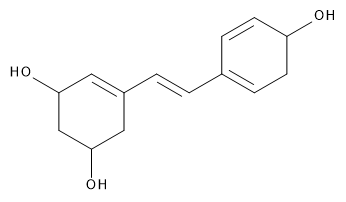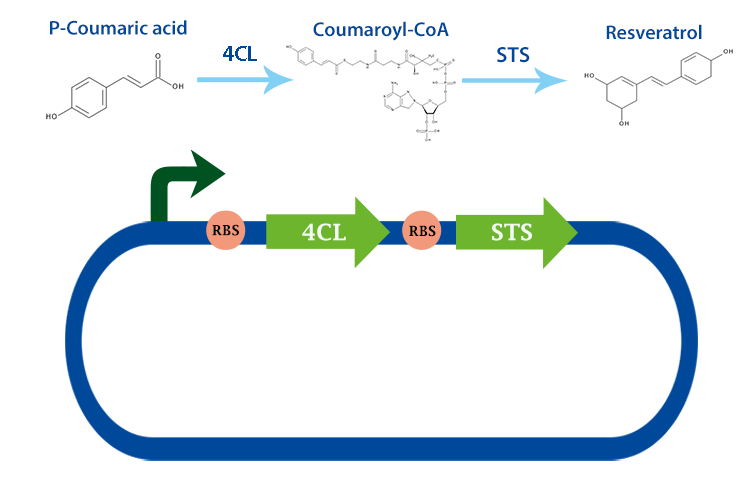
Resveratrol
Resveratrol (3,5,4′-trihydroxystilbene)
|
In our search for substances to put in our yoghurt we looked around in articles for molecules with good health effects. From the start we found resveratrol to stand out as a well-studied substance with some huge potential benefits. We mainly consume it via red wine and it is perhaps the main reason for why wine is considered good for your health in reasonable amounts.
Resveratrol belongs to a group of molecules known as Phyloalexin which is used by many plants to battle infections of all sorts.
Since the early 90’s there has been many studies done on resveratrol showing it has a wide range of beneficial properties ranging from skin cancer reduction to anti-inflamatory effects and antioxidant properties.
Perhaps the most interesting property is that of life extension. With 2.1 billion people being overweight worldwide obesity related diseases are one of humanities greatest health problems today.
Researchers now believe resveratrol is an caloric restricting substance reducing the effect of high caloric food and therefore increasing life expectancy.
|
 |
Methods
Three enzymes is needed to produce resveratrol. Here we have characterized two of them, 4 coumarate ligase and stilbene synthase. For the first enzyme in the pathway, see the page for tyrosine ammonia lyase. (link)
4-coumarate ligase (4Cl) and stilbene synthase (STS) was from arabidophsis thaliana and vitis vinifiera was obtained from J.Conrado et al. [1]. We biobricked 4Cl and STS with the ribosome binding site B0034 and overhangs in a single pcr. We also made a version with 6-HIS-tag for enzyme expression analysis. After biobricking the two enzymes, we coupled them together to create a operon consisting of 4Cl and STS.
We have expressed 4Cl and STS in e-coli DH5alpha and E-coli nissle, a probiotic e-coli obtained from Trieste iGEM 2012. 4Cl and STS will also be characterized in lactobacillus, by transforming the construct with our shuttle vector.

Results
Biobrick
We succeded in the cloning and sequencing of our two biobricks, 4-Coumarate ligase from
arabidophsis thaliana and Stilbene synthase from vitis vinifiera with the RBS B0034 that should work
in various organisms, lactobacillus and e-coli. Sequencing was done at GATC biotech and Uppsala
Genome center using sanger sequencing.
We also succeded in the making of our operon containing 4Cl and STS together.
BBa_K1033001: 4-Coumarate ligase with rbs
BBa_K1033002:Stilbene synthase with rbs
BBa_K1033003: 4Cl-STS both with rbs
Western blot
We also succeeded in expressing the enzyme stilbene synthase in e-coli. Altough our expression of the protein was very weak, and due to time constraints we were not able to optimize our experiment.
To enable the detection of this protein by anti-his antibodies, 6-histidine tags was incorporated in the sequence. This way we could detect our enzyme with anti-his antibodies.
We expressed our protein with a multipromotor working in both lactobacillus and e-coli. This way, we can easily transfer stilbene synthase to lactobacillus later on.
The size of our protein was calculated using ProtParam
[5], 43 kDA.
HPLC
We tested our biobrick 4Cl-STS on HPLC, by adding p-coumaric acid as a precursor. The result we saw was quite unclear. We saw that the e-coli produced something out of the ordinary, but the absorbation was low and the peaks did not exactly match the standard. The peak at around ~33 min could correspond to our standard, but it is unclear. We theorize it is something in the actual hplc measurement that fails, or that something happens to our resveratrol metabolite in our e-coli.
4Cl-STS translational fusion expressed in e-coli
![]() Figure 1: E-coli supposed to produce resveratrol. As we can see, we got very low concentration peaks at ~30 min, ~33 min and ~36 min.
Resveratrol standard
Figure 1: E-coli supposed to produce resveratrol. As we can see, we got very low concentration peaks at ~30 min, ~33 min and ~36 min.
Resveratrol standard
![]() Figure 2: Resveratrol standard that is scaled down to correspond to the absorbations of our e-coli supposed to produce the corresponding metabolite. The peaks are at around ~33 and ~34.
Figure 2: Resveratrol standard that is scaled down to correspond to the absorbations of our e-coli supposed to produce the corresponding metabolite. The peaks are at around ~33 and ~34.
Sinclair, D. A & Baur, Y, A. Therapeutic potential of resveratrol:
the in vivo evidence. Nature 506 | JUNE 2006 | VOLUME 5
Baur, Y, A. et al. Resveratrol improves health and survival
of mice on a high-calorie diet. Nature Vol 444| 16 November 2006
 "
"












